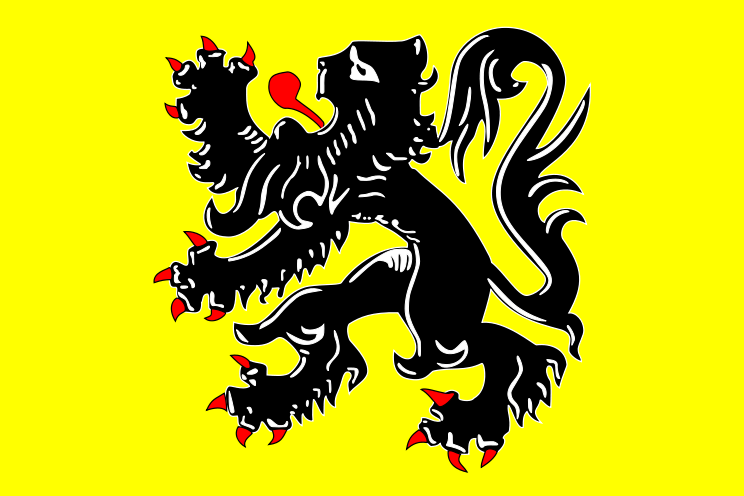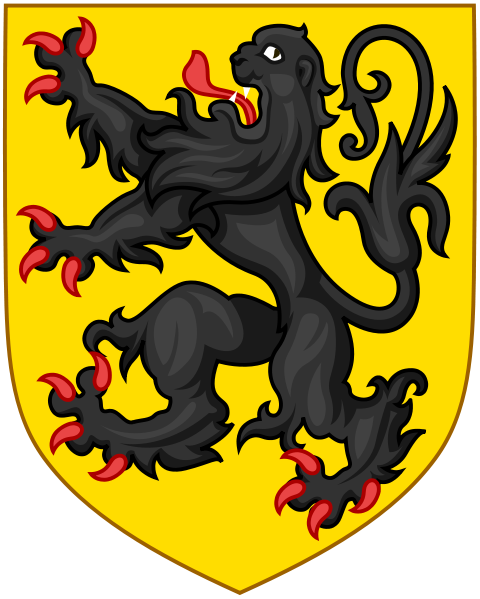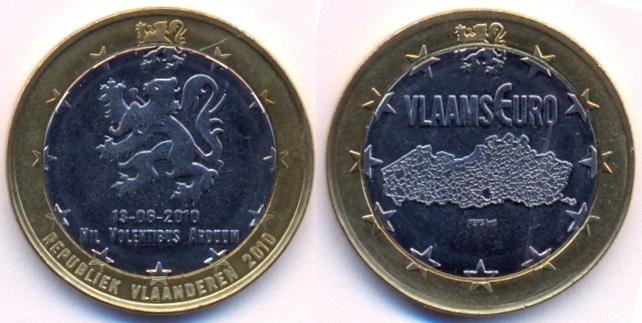|
 |
 |
|
Flanders (Flemish
Republic) |
| |
 |
 |
| |
|
Over the course of history, the geographical territory that was called
"Flanders" has varied. From around 1000 AD, Flanders historically meant to
English-speaking peoples the land situated along the North Sea from the
Strait of Dover to the Scheldt estuary with ill-defined southern borders. It
came to refer specifically to the County of Flanders, lasting from 862 to
1795, whose territory was situated in the northwestern part of what is now
Belgium (the Belgian provinces of West Flanders and East Flanders), with
extensive portions in what is now northern France (French Flanders), and a
small area that is now part of the Netherlands (Zeelandic Flanders). Through
marriage, the County of Flanders was joined with most of the rest of the Low
Countries around 1400 AD, and it lost its independence. Most of the county's
territory became part of an independent Belgium in 1830, and during the 19th
and 20th centuries, it became increasingly commonplace to refer to the
entire Dutch-speaking and northern part of Belgium as "Flanders", including
the Belgian parts of the Duchy of Brabant and Limburg. In the late 20th
century, Belgium became a federal state in which the Dutch-speaking part was
given autonomy as the Flemish Community (Dutch: Vlaamse Gemeenschap) and the
Flemish Region (Dutch: Vlaams Gewest); these two entities were effectively
merged, and Flanders now refers to the territory of the Flemish Community,
which additionally has partial jurisdiction over Brussels. |
 |
|
Geographically, Flanders is generally flat, and has a small section of coast
on the North Sea. Flanders borders France to the west, the Netherlands to
the north and east, and Wallonia to the south. The Brussels Capital Region
is enclaved within the Flemish Region, while Voeren is an exclave of
Flanders between Wallonia and the Netherlands. Flanders is agriculturally
fertile and densely populated. |
|
Flanders has figured prominently in European history. During the late Middle
Ages, Flanders' trading towns (notably Ghent, Bruges and Ypres) made it one
of the richest and most urbanized parts of Europe, weaving the wool of
neighbouring lands into cloth for both domestic use and export. As a
consequence, a very sophisticated culture developed, with impressive
achievements in the arts and architecture, rivaling those of northern Italy.
As part of Belgium, Flanders was initially the poorer half of the country to
industrialized Wallonia. In the second half of the twentieth century,
however, there has been a gradual shift of political and economic power to
Flanders, which, having modernized its economy, is now more wealthy and
prosperous than its southern counterpart. |
| The
Minister-President of Flanders (Dutch: Minister-president van Vlaanderen) is
the head of the Flemish Government, which is the executive branch of the
Flemish Region and Flemish Community. Usually the leader of the largest
party of the Flemish Parliament becomes the minister-president. Regional
elections are held every 5 years. The Flemish Parliament was elected
directly for the first time in 1995. Prior to 1995, the members of the
Flemish Parliament were the members of the Dutch language group of the
Federal Parliament of Belgium. |
| |
-
Minister-President of Flanders
- Gaston C. S. A.
Geens.............................22 Dec 1981 - 21 Jan 1992
- Luc Van den Brande................................21
Feb 1992 - 13 Jul 1999
- Patrick Yvonne
Hugo Dewael........................13 Jul 1999 - 05 Jun 2003
- Renaat Julien
Landuyt (acting)....................05
Jun 2003 - 11 Jun 2003
- Bartolomeus Jozef
Lodewijk Rosalia "Bart" Somers..11 Jun 2003 - 20 Jul 2004
- Yves Camille
Désiré Leterme.......................20 Jul 2004 - 28 Jun 2007
- He also served as the
Prime Minister of Belgium from 25 November 2009 to 06 December 2011.
- Kris Peeters......................................28
Jun 2007 - date
|
| |
|
 |
1 Euro. Year:
2010. Weight:
7.55g. Metal:
Bi-metallic; Brass in outer ring and Copper-Nickel
in center.
Diameter:
26 mm. Edge:
Reeded and Plain; 5 patches each. Alignment:
Medal. Mint:
N/A. Obverse:
Flanders Emblem with "13-06-2010 NIL
VOLENTIBUS ARDUUM" below it. "REPUBLIEK VLAANDEREN 2010" at the
bottom. 11 stars around. Reverse:
"VLAAMS EURO" written above Dutch speaking north Belgium map in the
center. "PEPS Intl" written below map. 11 stars around. Mintage:
N/A.
Minted Years: One year
type. |
|
| |
| For
over a year, Belgium has not been able to create a national government
because of disagreements between the French speaking portions and the Dutch
speaking portions of the country. Despite the lack of a national government
(or maybe because of a lack of a national government), Belgium is doing
better economically than most of Europe. A number Belgians have advocated
breaking the country into two separate nations. Flanders is the Dutch
speaking northern part of Belgium. This 2010 1 Euro fantasy coin was created
for the Flemish Republic, which does not yet exist independently. One side
has a map of Flanders with the legend Vlaams €uro (Flemish Euro). The other
side features a Flemish lion. |
|
On 13 December 2006, a spoof
news broadcast by the Belgian Francophone public broadcasting station
RTBF declared that Flanders had decided to declare independence from
Belgium. |
|
The 2007 federal elections
showed more support for Flemish autonomy. All the political parties that
advocated a significant increase of Flemish autonomy gained votes as
well as seats in the Belgian parliament. Several negotiators having come
and gone since the federal elections of 10 June 2007 without diminishing
the disagreements between Flemish and Walloon politicians regarding a
further State reform, causing difficulties for the formation of the
federal government and ultimately leading to the fall of the government
and new elections on 13 June 2010. These were won by the
pro-independence party of the N-VA in Flanders. The long-lasting
government formation of 2010 broke the previous record of 2007. |
|
|
|
|
| |
|
|
| |
|
Micro-Nations |
| |
|
Chiefa Coins |
|
|





